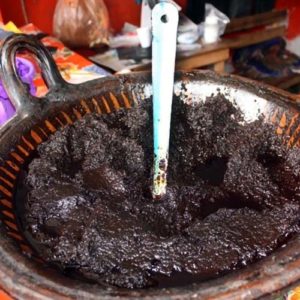The mole de Xico or mole xiqueño is not as universally known outside of Mexico as the elegantly balanced mole poblano or as famous inside Mexico as the super-elaborate mole negro oaxaqueño (named for their cities of origin in neighboring Puebla and Oaxaca). But it’s equally important in its own right.
Every cook in the town of Xico can point out something a little different about her or his mole xiqueño. The constants are these: The sauce must be sweet and almost marmalade-like, a rich concentrate containing a lot of nuts and seeds (preferably many kinds), a combination of dried and fresh fruits, corn tortillas and bread (usually both) for extra thickening, and a not-too-dominant medley of dried herbs and spices. It demands the flavor of good lard (this is not a case where oil would be a proper substitute). And for the right brown-black color you must use very dark chiles, generally mulatos and/or pasillas.
This is probably the most labor-intensive dish in the book. To me it doesn’t seem horribly demanding — perhaps because I’ve spent so many hours wrestling with some of the most complex Oaxacan moles! Yes, it does take the patience to keep frying and puréeing one group of ingredients after another ad infinitum (it feels like), but the following version — my free interpretation of a recipe shared by Enriqueta Izaguirre de Virués — has the great advantage that virtually all of the heavy-duty puréeing can be done in one machine, the food processor. I’ve broken down the work into separate parts — the nuts, the fruits, the chiles, etc. — that don’t always have to be done in the same sequence. Indeed, the beauty of the recipe is its flexibility. Not only can you do the important preliminary steps in any order you prefer (or almost any order — for best flavor, the spices and aromatics should be left until last), but you can usually take a breather from one process when you want and come back to it afterward. For instance, you can remove the tops and seeds from the chiles the day before, if you don’t feel like cooking and/or puréeing the chiles right after the long job of seeding them, you can break off the chile preparation at any point whatever and return to it later — maybe after tackling the nuts and fruits. And any one step — or all of them — before preparing the spice and aromatics can be done several hours ahead.
Please note that the recipe makes about 4 quarts of a thick, heavy paste that keeps well for weeks or months (people in Xico wouldn’t go to all that trouble for just one meal’s worth!). To use it, take a few cups of the paste and thin it to a slightly loose, pourable consistency with stock, using about ¾ cup of liquid per cup of paste. The Mexican way would be to have some chicken or pork lined up for the meal, simmer it until halfway done in a little water, use some of the cooking liquid to thin the mole, and then finish cooking the meat in the sauce. For 6 servings, plan on using 3 cups of the basic paste thinned with 2½ cups of stock.

Mole from Veracruz (Mole de Xico)
Ingredients
For frying
- ¾ cup lard, preferably
home-rendered , divided (approximate amount)
For the chiles
- ¾ pound mulato chiles or a combination of mulato and pasilla chiles about 40 chiles
For the nut-seed mixture
- ½ cup pine nuts
- 1 cup slivered almonds
- ½ cup pecan halves or pieces
- ¼ cup hulled pumpkin seeds
- ¼ cup sesame seeds
- ½ cup roasted peanuts
- ½ cup roasted skinned hazelnuts
For the fruit mixture
- 1¼ cups pitted prunes
- ½ cup dark raisins
- 3 crisp, tart-sweet apples (I use Granny Smith) peeled, cored, and cut into ½-inch slices
- 1 ripe plantain peeled and cut into ½-inch slices
For the thickening
- 2 commercial corn tortillas cut into 1-inch strips
- 1 French roll cut into ½-inch slices, or 5-6 ½-inch slices of good French or Italian bread
For the spice mixture
- 1 2-inch piece of
canela - ½ teaspoon aniseed
- ½ teaspoon dried Mexican or Mediterranean oregano crumbled
- 2 whole cloves
- ½ teaspoon black peppercorns
For the aromatics
- 1 large white onion unpeeled
- 2-3 large ripe tomatoes about 1 pound
- 8 cloves garlic unpeeled
To finish
- 1 3-ounce Mexican chocolate tablet grated
- 2 tablespoons grated piloncillo Mexican brown loaf sugar or dark brown sugar
- 3 teaspoons salt
To prepare for serving
- Chicken or pork stock as needed
Instructions
Prepare the chiles
- Preheat the oven to 275ºF.
- Wipe the chiles clean with a damp cloth and let dry thoroughly. Spread the chiles out on baking sheets and bake for 20-30 minutes, until dark and hard. Be careful not to let them burn.
- Let sit until cool enough to handle and remove the tops and shake out the seeds; discard. Break the chiles into coarse pieces and grind to a powder in a food processor.
Prepare the nut-seed mixture
- Have ready all the nuts and seeds. In a large heavy-bottomed skillet, heat about 2 tablespoons of the lard over medium heat until rippling. Add the pine nuts and almonds; fry, stirring constantly, until golden, about 3-4 minutes. Scoop out with a slotted spoon into a heatproof bowl, letting as much fat as possible drain back into the pan. Add about 1 more tablespoon of the lard to the pan and let it heat to rippling. Add the pecans and fry in the same way for about 3 minutes, being careful not to scorch them (reduce the heat slightly if necessary). Scoop out as before into the same bowl; set the skillet aside for later.
- Heat a small, dry skillet over medium heat and add the pumpkin seeds. Toast, stirring constantly, for 3 minutes or less, just until they start swelling up and popping. Quickly add to the bowl with the other nuts. Add the sesame seeds to the skillet and toast, stirring, until golden, about 2 minutes. Scrape out the toasted sesame seeds into the same bowl.
- Add the peanuts and hazelnuts to the bowl of nuts, stir to distribute everything evenly, and using a food processor, process to a very fine, smooth paste in 1 or 2 batches. Scrape out the nut paste into a bowl and set aside.
Prepare the fruit mixture
- Have ready all the dried and fresh fruits. In the skillet used for frying the nuts, heat another 2 tablespoons of the remaining lard to rippling over medium heat. Add the prunes and raisins; cook, stirring occasionally, for about 2 minutes or until they’ve absorbed some of the fat. Scoop out into a heatproof bowl. Add another 2 tablespoons of the lard to the skillet; when it ripples, add the sliced apples and plantain. Cook, stirring, until golden and slightly softened, about 5-7 minutes. Scrape out the sautéed fruit into the same bowl. Let cool slightly and using a food processor, process to a smooth purée. Scrape out the fruit, pour into a bowl and set aside.
Prepare the thickening ingredients
- Have ready the tortillas and bread. Rinse out and dry the skillet (to remove any scorch-prone residue of the fruit). Add another 2 tablespoons of the lard, heat to rippling over medium heat, and add the tortilla strips. Fry, stirring frequently, for about 3-4 minutes, or until golden. Lift out onto absorbent paper towels and set aside to drain. In the same pan, fry the bread slices until golden on both sides, allowing about 2 minutes per side. Lift out to drain in the same way.
Prepare the spices and aromatics; finish the mole
- You have now finished all the major pre-preparations. When you are ready to finish assembling the mole, have ready the canela, aniseed, oregano, cloves, and peppercorns. Heat a small, dry skillet over medium heat. Add the canela and toast for 1 minute. Add the other seasonings; shaking the skillet occasionally, toast until fragrant, about 2 minutes longer. Let cool to room temperature, then grind very fine using a mortar and pestle or an electric coffee or spice grinder. Set aside.
- Have ready the onion, tomatoes, and garlic. Griddle-roast and peel them all. Place the roasted vegetables in a blender (my preference) or food processor with the fried tortillas and bread and process to a coarse paste.
- Add the remaining lard (probably about 3-4 tablespoons) to a large Dutch oven or saucepan set over medium heat. When it ripples, add the onion-tortilla mixture and the ground spices. Cook, stirring occasionally, for about 10 minutes or until the flavors are mellowed. In any preferred order, stir in the ground chiles, nuts, and fruits. Bring to a boil and cook, stirring frequently, 3-5 minutes or until well combined. Stir in the grated chocolate, piloncillo, and salt; cook, uncovered, for another 20-30 minutes, stirring frequently to keep it from scorching.
- Remove the mole from the heat, let cool to room temperature, and store in sealed containers. It will keep for up to 4-5 weeks in the refrigerator, or indefinitely in the freezer. To dilute with stock for use as a sauce, refer to the accompanying post.

